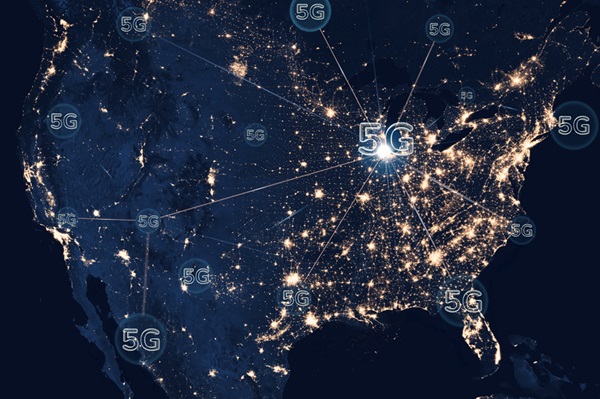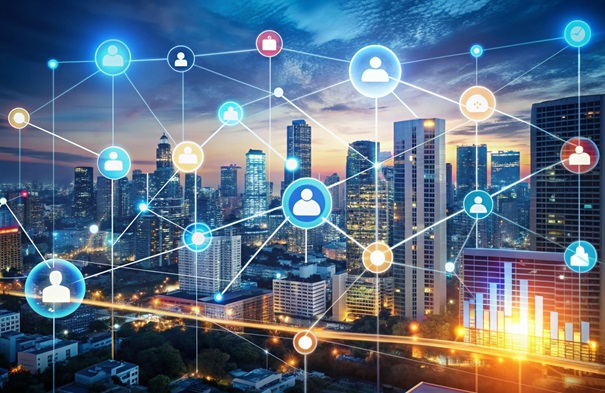5G technology marks a revolutionary advancement in mobile communication, offering unprecedented speeds, reduced latency, and increased connectivity. Unlike its predecessors, 5G is designed to support a vast array of applications and devices simultaneously, transforming how we interact with technology. The impact of 5G Technology extends far beyond enhanced mobile internet; it fuels the growth of smart cities, revolutionizes industries, and enables new possibilities in connectivity. This introduction explores how 5G technology is reshaping the landscape of modern communication and driving innovation across various sectors.

I. Introduction
A. Overview of 5G Technology and Its Capabilities
5G technology represents the fifth generation of mobile networks, promising a transformative leap in connectivity. This next-generation technology is characterized by its unprecedented speed, minimal latency, and enhanced capacity. With 5G, users can experience download speeds up to 100 times faster than 4G, allowing seamless streaming, faster data transfer, and real-time communication. The enhanced connectivity capabilities of 5G are set to revolutionize various aspects of daily life, particularly through its integration into smart city infrastructures.
B. Importance of 5G for Next-Generation Connectivity
The importance of 5G technology lies in its ability to provide a foundation for next-generation connectivity. As digital demands continue escalating, 5G offers the bandwidth and efficiency to support the growing number of connected devices and applications. This advanced network technology is crucial for fostering innovation and facilitating the development of smart cities, where interconnected systems rely on rapid and reliable communication.
C. Objectives of the Article: Exploring the Role of 5G in Shaping Smart Cities
This article explores the role of 5G technology in shaping smart cities by examining its capabilities, impact on connectivity, and contributions to urban development. We will delve into how 5G enhances various aspects of smart city infrastructure, its influence on connectivity and innovation, and the challenges associated with its implementation. By understanding these elements, we can appreciate the transformative potential of 5G technology in creating more efficient, sustainable, and intelligent urban environments.
II. Understanding 5G Technology
A. Key Features of 5G Networks
1. Increased Speed and Reduced Latency
One of the most significant impacts of 5G technology is its dramatic increase in speed and reduction in latency. With 5G, data can be transmitted at speeds exceeding 10 Gbps, compared to 100 Mbps with 4G. This leap in speed enables near-instantaneous communication and data exchange, which is essential for real-time applications in smart cities, such as autonomous vehicles and intelligent transportation systems.
2. Enhanced Capacity and Connectivity
5G technology also brings enhanced capacity and connectivity. It supports a vast number of connected devices within a given area, accommodating the Internet of Things (IoT) and smart city infrastructure. The increased network capacity allows for improved performance and reliability, even in densely populated urban environments, thus reinforcing the impact of 5G technology on city infrastructure and services.
B. Differences Between 5G and Previous Generations of Wireless Technology
5G differs from previous generations, such as 4G, in several key ways. While 4G networks offered substantial improvements over 3G, 5G pushes the boundaries even further with higher data rates, lower latency, and greater device density. Unlike 4G, which primarily focuses on improving mobile internet speeds, 5G is designed to support a wide range of applications, including smart cities, augmented reality (AR), and industrial automation, reflecting the broader impact of 5G technology on connectivity and technology.
C. Benefits of 5G for Consumers and Industries
The benefits of 5G technology are substantial for both consumers and industries. For consumers, 5G provides faster internet speeds, improved streaming quality, and enhanced mobile experiences. Industries benefit from 5G through increased operational efficiency, innovative applications, and the ability to deploy advanced technologies like IoT and AI. The impact of 5G technology extends to various sectors, driving progress and enabling new possibilities in connectivity and smart city development.
III. 5G and Enhanced Connectivity
A. The Role of 5G in Expanding the Internet of Things (IoT)
1. Connecting More Devices with Greater Efficiency
5G technology significantly impacts the Internet of Things (IoT) by enabling the connection of a larger number of devices with greater efficiency. Unlike previous generations, which faced limitations in handling massive numbers of connections, 5G supports up to 1 million devices per square kilometer. This capability is crucial for smart cities, where numerous sensors, cameras, and devices must communicate seamlessly.
2. Applications of 5G in IoT-Driven Solutions
The impact of 5G Technology on IoT-driven solutions is profound, facilitating applications such as smart traffic management, environmental monitoring, and automated buildings. With 5G, data from IoT devices can be transmitted and processed in real time, leading to more effective and responsive systems that enhance urban living and infrastructure management.
B. Supporting High-Density Urban Environments
1. Network Scalability for Large Populations
5G technology offers exceptional network scalability, making it well-suited for high-density urban environments. In cities with large populations, 5G can manage extensive network traffic and support a high number of simultaneous connections. This scalability is crucial for maintaining connectivity and performance in bustling urban areas, reinforcing the impact of 5G Technology on city infrastructure.
2. Seamless Connectivity in Smart Cities
Seamless connectivity is a cornerstone of smart cities, and 5G technology plays a vital role in achieving this goal. By providing reliable and high-speed connectivity across various city services and systems, 5G ensures that smart city technologies operate effectively and efficiently. This impact is evident in areas such as public transportation, emergency services, and utility management.

IV. The Impact of 5G Technology on Smart Cities
A. Enhancing Infrastructure and Public Services
1. Intelligent Transportation Systems (ITS)
5G technology significantly enhances intelligent transportation systems (ITS) by enabling real-time communication between vehicles, infrastructure, and traffic management systems. This connectivity improves traffic flow, reduces congestion, and enhances safety. For instance, 5G-powered vehicle-to-everything (V2X) communication allows for better coordination of autonomous vehicles and traffic signals, demonstrating the impact of 5G Technology on transportation efficiency.
2. Smart Grids and Energy Management
Smart grids and energy management systems benefit greatly from 5G technology. With its ability to provide real-time data and communication, 5G enables more effective monitoring and control of energy resources. This capability leads to improved energy distribution, reduced waste, and enhanced management of renewable energy sources, illustrating the impact of 5G Technology on sustainable urban development.
B. Improving Urban Planning and Sustainability
1. Real-Time Data for Smart Resource Allocation
5G technology enhances urban planning by providing real-time data that supports smart resource allocation. This data-driven approach allows city planners to optimize the use of resources such as water, electricity, and public services, leading to more efficient and sustainable urban environments. The impact of 5G Technology on data collection and analysis is crucial for effective urban management.
2. Reducing Carbon Footprints and Optimizing Utilities
The integration of 5G technology in smart city infrastructure contributes to reducing carbon footprints and optimizing utilities. By enabling advanced monitoring and control systems, 5G helps cities implement energy-efficient solutions and reduce emissions. This impact of 5G technology aligns with the broader goals of creating greener and more sustainable urban areas.
C. Case Studies: Early Adoption of 5G in Smart Cities
Case studies of cities that have adopted 5G technology provide valuable insights into its impact on smart city development. Cities such as Seoul, Shenzhen, and San Francisco have implemented 5G networks to enhance various aspects of urban life, from transportation to public safety. These examples highlight the transformative potential of 5G and offer lessons for other cities pursuing smart city initiatives.
V. 5G-Driven Innovations in Smart City Technology
A. Smart Buildings and Automation
1. Enhancing Efficiency and Energy Use
5G technology drives innovation in smart buildings by enabling advanced automation and energy management systems. Connected devices and sensors within smart buildings provide real-time data on energy usage, occupancy, and environmental conditions. This data allows for more efficient energy use and automated adjustments, improving overall building performance and sustainability.
2. Connected Devices for Real-Time Monitoring
The impact of 5G technology on smart buildings extends to real-time monitoring and control. Connected devices, such as smart thermostats and lighting systems, rely on 5G to communicate seamlessly and make data-driven decisions. This connectivity enhances building management and occupant comfort, showcasing the benefits of 5G in creating intelligent and responsive environments.
B. Autonomous Vehicles and 5G
1. Enabling Vehicle-to-Everything (V2X) Communication
5G technology is crucial for the development of autonomous vehicles, enabling vehicle-to-everything (V2X) communication. This capability allows vehicles to interact with other vehicles, infrastructure, and traffic management systems in real-time. The impact of 5G Technology on autonomous driving includes improved safety, better traffic management, and enhanced overall driving experience.
2. Improving Traffic Management and Safety
The integration of 5G with autonomous vehicles enhances traffic management and safety. Real-time data exchange between vehicles and traffic systems enables more efficient traffic flow, reduces accidents, and minimizes congestion. This impact of 5G technology is evident in smart traffic systems that use 5G technology to optimize signal timing and manage traffic patterns.
C. Public Safety and Emergency Response
1. Real-Time Monitoring and Predictive Analytics
5G technology enhances public safety and emergency response through real-time monitoring and predictive analytics. Connected sensors and cameras provide real-time data on public safety issues, such as crime and traffic incidents. Predictive analytics, powered by 5G, helps anticipate and address potential emergencies before they occur, improving overall safety and response times.
2. Enhancing First-Responder Communication
The impact of 5G Technology on first-responder communication is significant, providing faster and more reliable communication channels. Emergency services benefit from improved data transmission, video streaming, and coordination capabilities. This enhanced communication supports more effective and timely responses to emergencies, showcasing the role of 5G in public safety.
VI. Challenges and Considerations in 5G Implementation
A. Infrastructure Challenges and Deployment Costs
1. Building the Necessary Infrastructure for 5G Networks
The deployment of 5G technology involves significant infrastructure challenges, including the need for new cell towers, antennas, and network equipment. Building this infrastructure requires substantial investment and coordination, presenting financial and logistical challenges for cities and service providers.
2. Financial and Regulatory Barriers to Adoption
Financial and regulatory barriers also impact the adoption of 5G technology. The high costs associated with network deployment and the need for regulatory approvals can hinder the progress of 5G implementation. Addressing these barriers is essential for ensuring widespread adoption and realizing the full impact of 5G technology.
B. Data Security and Privacy Concerns
1. Addressing Vulnerabilities in a Hyperconnected Environment
The hyperconnected nature of 5G networks raises data security and privacy concerns. The increased number of connected devices and the vast amount of data transmitted create potential vulnerabilities that need to be addressed. Ensuring robust security measures is crucial for protecting sensitive information and maintaining trust in 5G-enabled systems.
2. Ensuring Privacy in Smart City Applications
Privacy concerns in smart city applications are another consideration. The collection and use of data from various sensors and devices must be managed carefully to protect individuals’ privacy. Implementing data protection policies and technologies is essential for safeguarding personal information in 5G-powered smart cities.
C. Managing the Environmental Impact of 5G Technology Deployment
The environmental impact of 5G Technology deployment is also a consideration, as the construction of new infrastructure and increased energy consumption can have ecological consequences. Sustainable practices and energy-efficient technologies should be incorporated into 5G deployment strategies to minimize the environmental footprint of network expansion.

VII. Future Trends in 5G and Smart Cities
A. 5G and the Growth of Artificial Intelligence in Urban Management
1. AI-Powered Automation in Smart Cities
The impact of 5G technology on artificial intelligence (AI) in urban management is significant. 5G enables AI-powered automation by providing the high-speed data transmission necessary for real-time analysis and decision-making. This integration allows for more intelligent and adaptive urban management systems, improving efficiency and responsiveness.
2. Data-Driven Decision-Making with 5G-Enabled AI
5G technology enhances data-driven decision-making through its ability to support large-scale data collection and analysis. AI systems leverage this data to make informed decisions and optimize various aspects of smart city operations, from traffic management to resource allocation, showcasing the synergy between 5G and AI.
B. Advancements in Augmented and Virtual Reality Applications
1. 5G and Immersive Experiences for Citizens
The impact of 5G Technology on augmented reality (AR) and virtual reality (VR) applications is transformative. With its high-speed connectivity and low latency, 5G enables immersive AR and VR experiences for citizens, enhancing entertainment, education, and training. These technologies benefit from the rapid data transfer and real-time interactions that 5G provides.
2. Impact on Education, Entertainment, and Commerce
The advancements in AR and VR applications driven by 5G technology have wide-ranging impacts on education, entertainment, and commerce. From interactive learning experiences to virtual shopping environments, 5G enables new possibilities and innovations in these sectors, demonstrating its far-reaching influence.
C. The Long-Term Vision for Fully Connected Smart Cities
1. Achieving Full Integration Across All Sectors
The long-term vision for smart cities involves achieving full integration across all sectors, facilitated by 5G technology. This integration includes seamless connectivity between various city systems, such as transportation, energy, and public services, creating a cohesive and efficient urban environment.
2. Predictions for the Next Decade of 5G and Smart City Evolution
Predictions for the next decade that the impact of 5G technology will continue to advance, significantly influencing the development of smart cities. As 5G networks evolve, we can expect further innovations in connectivity, automation, and urban management. The future of smart cities will be shaped by these developments, leading to more intelligent, sustainable, and connected urban environments.
VIII. Case Studies and Examples
A. Success Stories of Cities Implementing 5G Infrastructure
1. Notable Global Smart Cities Leveraging 5G
Cities such as Seoul, Shenzhen, and San Francisco have successfully implemented 5G infrastructure, showcasing the transformative impact of 5G technology. These smart cities leverage 5G to enhance various aspects of urban life, from transportation to public safety, providing valuable examples of successful 5G integration.
2. Impact of 5G Technology on Urban Living and Citizen Experiences
The impact of 5G technology on urban living and citizen experiences is evident in these case studies. Improved connectivity, enhanced services, and innovative applications demonstrate how 5G contributes to a better quality of life and more efficient city management.
B. Lessons Learned and Key Takeaways for Future Projects
Lessons learned from successful 5G implementations offer key takeaways for future projects. Best practices include careful planning, addressing infrastructure challenges, and ensuring robust security measures. These insights can guide other cities in their efforts to adopt and benefit from 5G technology.
IX. Conclusion
A. Recap of the Transformative Impact of 5G Technology on Connectivity and Smart Cities
The transformative impact of 5G technology on connectivity and smart cities is profound. By providing faster speeds, lower latency, and enhanced capacity, 5G enables new possibilities in urban management, infrastructure, and public services. The benefits of 5G are evident in various aspects of smart city development, from improved transportation to more efficient energy management.
B. Strategic Recommendations for Cities Adopting 5G Technology
Strategic recommendations for cities adopting 5G technology include investing in infrastructure, addressing financial and regulatory barriers, and prioritizing data security. By following these recommendations, cities can maximize the benefits of 5G and create more connected and efficient urban environments.
C. Final Thoughts on the Future of Smart Cities Powered by 5G
The future of smart cities powered by 5G technology holds great promise. As 5G continues to evolve, it will play a pivotal role in shaping the next generation of urban environments. Embracing 5G technology will drive innovation, enhance connectivity, and improve the overall quality of life in smart cities around the world.

